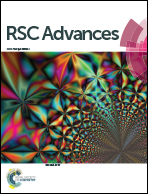Cu–Cd–Zn–S/ZnS core/shell quantum dot/polyvinyl alcohol flexible films for white light-emitting diodes†
Abstract
We present a facile route for the synthesis of water-soluble Cu–Cd–Zn–S/ZnS core/shell quantum dots (QDs) by simple pH regulation. The PL spectra of Cu–Cd–Zn–S/ZnS core/shell quantum dots can cover the whole visible light region in the case of only two ratios of Cu/Cd/Zn. The emission wavelength of Cu–Cd–Zn–S/ZnS QDs can be conveniently tuned from 474 to 515 and 548 to 629 nm by adjusting the pH value when the ratios of Cu/Cd/Zn are fixed at 1 : 5 : 80 and 1 : 5 : 10, respectively. It is worth noting that under the condition of a constant Cu/Cd/Zn ratio, the UV-vis absorption spectra do not change with the fluorescence spectra, indicating that the band gap of QDs remains unchanged during the change of pH value. The photoluminescence (PL) quantum yield of the as-prepared QDs with yellow emission is up to 76%. The QDs also show excellent chemical stability after the deposition of the ZnS shell. Luminescent and flexible films are fabricated by combining Cu–Cd–Zn–S QDs with polyvinyl alcohol (PVA). The QD/PVA flexible hybrid films are successfully applied on top of a conventional blue InGaN chip for remote-type warm-white LEDs. As-fabricated warm-white LEDs exhibit a higher color rendering index (CRI) of about 89.2 and a correlated color temperature (CCT) of 4308 K.



 Please wait while we load your content...
Please wait while we load your content...